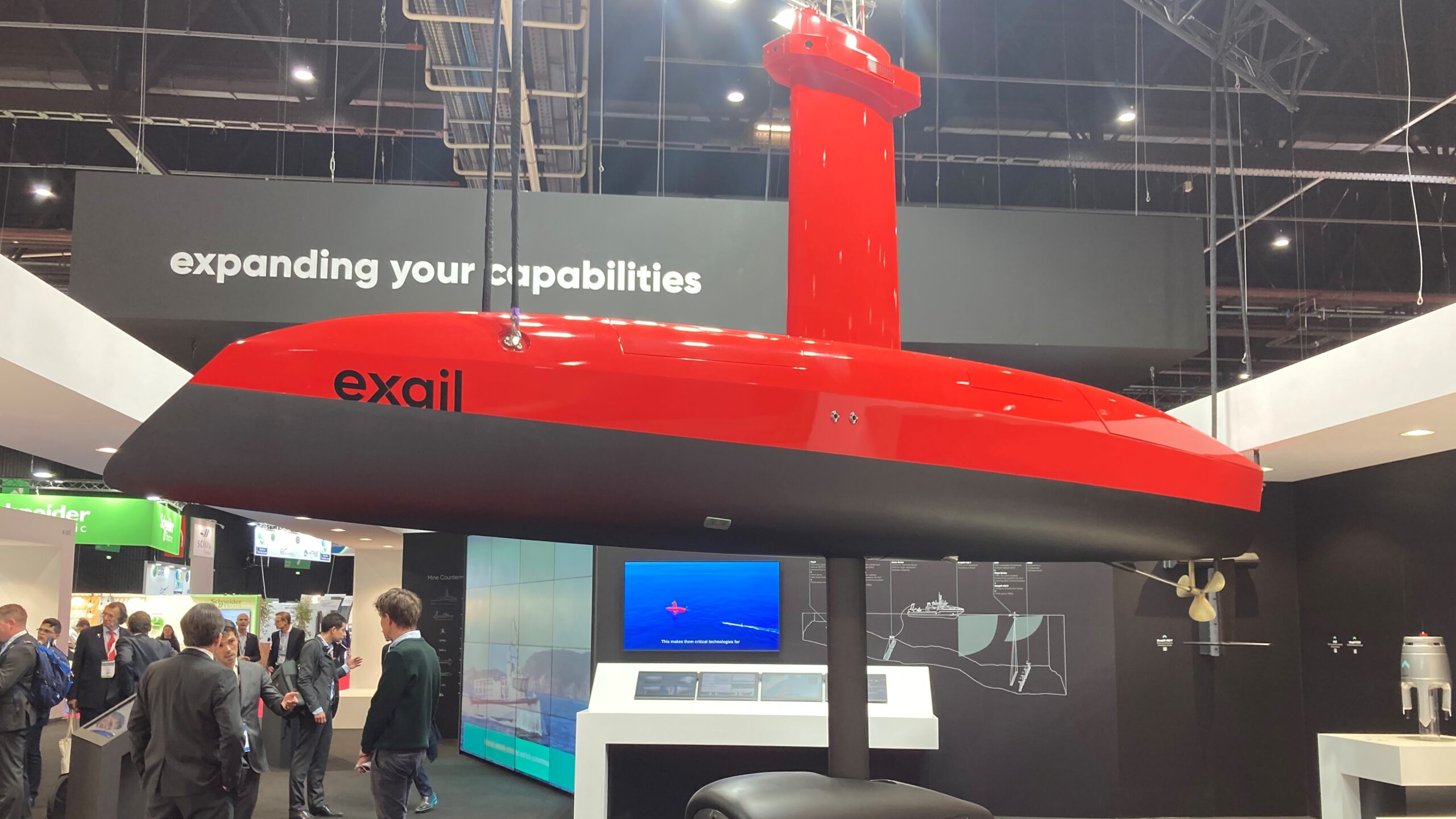
The Exail booth at Euronaval in 2022. (Christina Mackenzie/Breaking Defense)
EURONAVAL 2022 — Two French naval robotics firms, ECA Group and iXblue, announced here at the show that they are joining forces, with their individual brands replaced by a new, single brand, Exail.
The new company, which will continue work in the fields of robotics, maritime navigation, aerospace and photonics, now has a workforce of 1,500 spread over 21 offices in France and 11 in the rest of the world. Its expected annual revenue will be €250 million ($244.4 million), according to company documents. It also has one of the largest stands at the show, showcasing, amongst other things, its mine countermeasure solutions and the eye-catching, large, bright red DriX unmanned surface vessel (USV). More about that a bit later.
The merger, announced Tuesday, is the latest development in an evolution for both firms. Despite the name’s reference to aeronautics, ECA Group, which stands for Etude et Construction Aéronautique, turned its attention to maritime systems decades ago. Founded in 1936, it became a subsidiary of the family-owned high-tech company, Groupe Gorgé, in 1992 and although ECA Group was then merged with Gorgé in 2020, it kept its own identity.
FULL COVERAGE: Euronaval 2022
Gorgé then acquired iXblue on Sept. 29, saving the announcement for this year’s Euronaval, merging ECA Group and iXblue to create what it hopes to be a European high-tech industrial champion.
The ECA Group has been a frequent sub-contractor to larger European firms such as Airbus, Naval Group and Thales, providing them with robots and drones for mission-specific systems. ECA Group says its automated systems have been sold to over 80 countries.
For its part, iXblue, founded in 2000, specializes in advanced navigation, photonics and maritime autonomy solutions. But whereas ECA Group has specialized in automated undersea vessels (AUVs), iXblue has gone underwater, developing the DriX, which the company says can host a wide range of payloads notably for high-quality data acquisition in both shallow and deep waters. The eight-meter-long (26 feet) USV displaces 1.4 tonnes (1.54 tons), is propelled by a diesel engine and can sail continuously for seven days at seven knots or 24 hours at its top speed of 14 knots. It’s been bought by a US government agency, the National Oceanic and Atmospheric Administration (NOAA), the British Antarctic Survey (BAS), the Polish Navy, the French Hydrographic Institute (SHOM), the French Research Institute for Ocean Science (Ifremer), as well as survey contractors and operators in the energy market.
Prior to the official merger, ECA Group and iXblue had been partners for a long time. iXblue, for example, supplies the fiberoptic gyroscope (FOG) that gives the ECA Group’s robots their precise movements. FOG has no mechanical parts to cause vibration or friction and so is not only acoustically stealthy and robust but, because it relies only on the motion of light, it is resistant to shocks, extreme temperatures and magnetism so able to operate in extreme environments such as submarines, deep-water robots, satellites, long-range artillery and vehicles.
“In addition to our complementary activities, both our companies share a common DNA centered around innovation and entrepreneurship,” Fabien Napolitano, President & CEO of iXblue, said in a statement. “This acquisition by Groupe Gorgé, that puts iXblue and ECA Group under the same roof, will enable us to create new synergies and strengthen our capacity to invest in research and development to offer solutions that are always at the cutting edge of technology.” He added that “joining forces under a joint brand allows us to become a major global player capable of addressing new and larger markets, but also to federate our 1,500 employees around the same banner.”
Dominique Giannoni, CEO of ECA Group, added: “With the combination of the technological expertise and global footprint of the two companies, we will provide unmatched value to our customers through our comprehensive portfolio of products and solutions.
“Our world is facing many challenges, whether they are security, environmental or societal. At Exail, we are convinced that the development of disruptive technologies will enable us to rise to these new challenges,” he said. He added that “this operation consolidates our leadership in our markets and offers excellent growth prospects. The teams of our two companies have already started working closely together. We see great development opportunities that we are eager to share with our customers.”
At the show Exail announced it had already formed a technological partnership with Mission Systems Pty Ltd, an Australian SME whose technology will be implemented in Exail’s mine countermeasures solutions including within the framework of Australia’s SEA 1905 Mine Countermeasures Program. Why 1905? Because if you write it in Roman numerals it reads MCMV i.e; mine countermeasure vessel!)
Exail said in a statement that the partnership would center on sonar simulation and machine learning. “It will enable Exail to fit its maritime drones with advanced technology from Mission Systems, providing navies with the next generation of autonomous solutions. Exail teams have already started to integrate Mission Systems technology in its drone mission management software UMISOFTTM in its DM (Data Management) module,” the statement said.
It added that “future areas of collaboration could extend outside of MCM, to other military applications such as Military Survey and Seabed Warfare as well as maritime civil applications.”






















